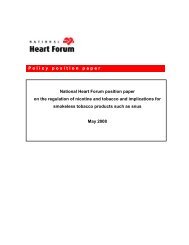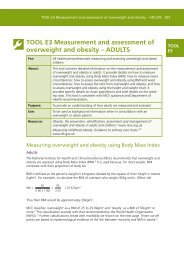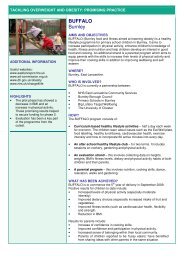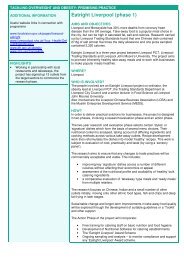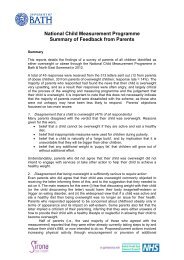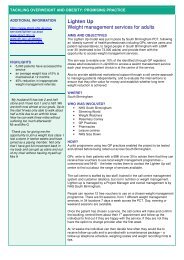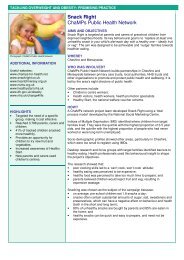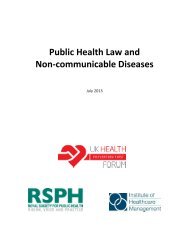The Challenge of Non-Communicable Diseases and Road Traffic ...
The Challenge of Non-Communicable Diseases and Road Traffic ...
The Challenge of Non-Communicable Diseases and Road Traffic ...
Create successful ePaper yourself
Turn your PDF publications into a flip-book with our unique Google optimized e-Paper software.
62 <strong>The</strong> <strong>Challenge</strong> <strong>of</strong> <strong>Non</strong>-communicable <strong>Diseases</strong> <strong>and</strong> <strong>Road</strong> <strong>Traffic</strong> Injuries in Sub-Saharan Africa<br />
TABLE 12: Illustrative HIV/AIDS Program Innovations<br />
Stewardship<br />
Financing <strong>and</strong> payments<br />
Human resources<br />
Infrastructure<br />
Commodities<br />
/supply chain<br />
Information /data<br />
Clinical services<br />
Transparent target-setting; ‘Three Ones’ principles * ; support for decentralization<br />
Performance-based financing, elimination <strong>of</strong> user fees, <strong>and</strong> innovative insurance schemes<br />
Training, mentoring, task-shifting, task-sharing, <strong>and</strong> engaging PLWH in care <strong>and</strong> support<br />
Renovations <strong>and</strong> repairs <strong>of</strong> clinical, counseling, laboratory, <strong>and</strong> pharmacy space<br />
Development <strong>and</strong> strengthening <strong>of</strong> procurement systems<br />
On-site medical records, electronic medical records, <strong>and</strong> ‘Three Ones’ approach<br />
Family-focused care, adherence support, <strong>and</strong> comprehensive primary care for PLWH<br />
Behaviors <strong>of</strong> providers<br />
<strong>and</strong> patients<br />
Multi-disciplinary teams, prominent use <strong>of</strong> counselors <strong>and</strong> peer educators, increased focus<br />
on adherence <strong>and</strong> psychosocial support, <strong>and</strong> enhanced dem<strong>and</strong>/uptake <strong>of</strong> services<br />
Source: [211]<br />
* In 2004, donors, developing countries, <strong>and</strong> UN agencies agreed to three core principles – known as the “Three Ones” – to better coordinate the scale-up <strong>of</strong><br />
national AIDS responses; namely, one agreed HIV/AIDS action framework that provides the basis for co¬ordinating the work <strong>of</strong> all partners; one national AIDS<br />
coordinating authority, with a broad based multi-sector m<strong>and</strong>ate; <strong>and</strong> one agreed country-level monitoring <strong>and</strong> evaluation system [425, 426].<br />
An integrated approach to the management <strong>of</strong><br />
chronic diseases in LMIC, irrespective <strong>of</strong> cause, is<br />
being called for increasingly [427]. Suggestions include<br />
integrating the management <strong>of</strong> chronic NCDs<br />
such as diabetes <strong>and</strong> hypertension with those <strong>of</strong><br />
chronic communicable diseases such as AIDS [428].<br />
A focus on broad care needs rather than disease<br />
categories could be more beneficial in planning<br />
services [177]; <strong>and</strong> the establishment <strong>of</strong> multidisciplinary<br />
chronic disease clinics with st<strong>and</strong>ardized<br />
approaches could improve continuity <strong>of</strong> care [429],<br />
adherence to therapy [430], <strong>and</strong> in turn efficiency<br />
gains. It may also help to decrease the stigma <strong>of</strong>ten<br />
associated with some communicable diseases. Examples<br />
<strong>of</strong> ‘cross-fertilization’ <strong>of</strong> care between communicable<br />
<strong>and</strong> NCDs are given in Box 12.<br />
BOX 12: Cross-Fertilization <strong>of</strong> Care for Chronic Conditions<br />
Care models from HIV/AIDS, TB, <strong>and</strong> other communicable diseases are being extended or adapted to address other<br />
chronic conditions <strong>and</strong> co-morbidities.<br />
<strong>The</strong> DOTS framework (directly observed therapy, short-course) has been a cornerstone <strong>of</strong> TB control for over a decade.<br />
<strong>The</strong> model has also been developed to deliver ART successfully in Malawi, with simplified management protocols, uninterrupted<br />
drug supplies, <strong>and</strong> monitoring <strong>of</strong> st<strong>and</strong>ardized treatment outcomes <strong>and</strong> key contributory factors [431]. It was<br />
proposed that a similar paradigm could be adapted for NCDs [407] <strong>and</strong> aspects <strong>of</strong> the DOTS model have since been applied<br />
to the management <strong>of</strong> people with diabetes mellitus in Malawi [432].<br />
Care for people with HIV/AIDS was resourced <strong>and</strong> exp<strong>and</strong>ing in Cambodia, but care for diabetes, hypertension <strong>and</strong> other<br />
chronic diseases was limited. During a three-year project, multi-disciplinary chronic disease clinics were established to <strong>of</strong>fer<br />
integrated care for patients with HIV/AIDS, diabetes, <strong>and</strong> hypertension within the same clinic [428]. Services were well<br />
accepted by patients <strong>and</strong> continuity <strong>of</strong> care <strong>and</strong> adherence to treatment were achieved with good outcomes. Providing<br />
care for sero-positive patients <strong>and</strong> those with other conditions within the same facility also reduced HIV-related stigma.<br />
Chronic care models, more frequently used for the care <strong>of</strong> chronic NCDs, are also being applied to cover chronic diseases<br />
whatever their cause. Projects using such models to improve quality <strong>of</strong> care for chronic conditions such as HIV, hypertension,<br />
<strong>and</strong> diabetes are underway in Ug<strong>and</strong>a, Tanzania, <strong>and</strong> South Africa [5, 422-423, 433]. <strong>The</strong>re have also been moves to<br />
apply self-management programs from chronic NCDs to HIV care [434].



